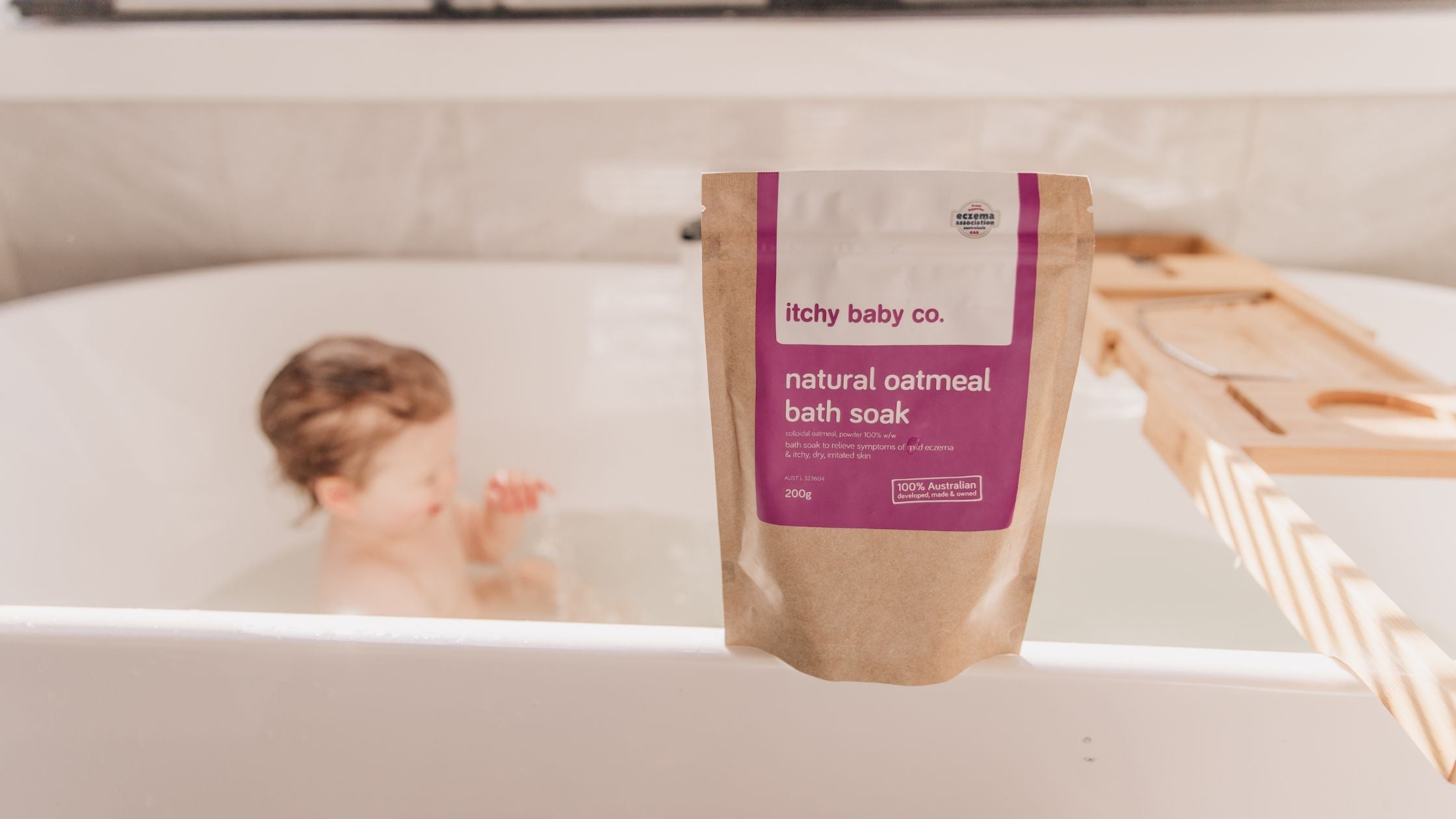How Can Oatmeal Baths Help My Child’s Problematic Skin?

How Can Oatmeal Baths Help My Child’s Problematic Skin?
Oatmeal – it’s delicious with a drizzle of local honey for breakfast, but have you thought about how this simple ingredient can help soothe itchy, dry skin prone to eczema? In this post, we’ll dive into the evidence-based benefits of oatmeal baths and why it could be a natural remedy worth trying for your itchy little one.
How can an oatmeal bath be effective for dry, itchy skin?
Research shows most of the benefits of having an oatmeal bath come from oatmeal’s chemical structure:
Beta Glucans
Beta-glucans hold in water and protect the skin, and may also assist in stimulating collagen production to strengthen the skin.
Cellulose and Fibre
Cellulose and fibre give oatmeal the ability to soften and moisturise the skin.
Phenols
Phenols have antioxidant and anti-inflammatory properties, helping reduce irritation and itching of your child’s eczema skin.
Saponins
Saponins are compounds found mainly in grains. They give colloidal oatmeal exceptional cleansing qualities to wash the skin and also take away any triggers sitting on the skin’s surface which can cause irritation and lead to infection.
Is using oatmeal for problematic skin a recent discovery?
No! Oatmeal has been used for hundreds of years to soothe problematic skin. The oldest oat grains were found in Egypt in about 2000 BC and were introduced to North America at the beginning of the 17th century. Colloidal oatmeal started to be used for cosmetic benefits in facial masks as well as for cleansing and relieving itching. In the mid 1900s, colloidal oatmeal became ready to use for skin care and in 2003, the US FDA approved it as a product that can relieve skin irritation and itching.
What new evidence is around to suggest colloidal oatmeal might be effective for children with eczema?
Studies have been conducted on colloidal oatmeal, as it has been used for centuries as a topical treatment for a range of skin conditions, including eczema.
A clinical trial was undertaken where extracts of colloidal oatmeal were made with numerous solvents and tested in antioxidant and anti-inflammatory assays. A blind study was also carried out with 29 healthy females who displayed mild to moderate itch with dry skin on their lower legs. After treatment with a colloidal oatmeal skin lotion, results showed significant clinical improvements in skin dryness, roughness and the magnitude of itchiness. These results provided evidence that colloidal oatmeal does contribute to anti-inflammatory and antioxidant properties, benefiting the skin, and may be used to treat the symptoms of eczema (Reynertson KA et al., 2015; PubMed 2015).
In a double blind, active-controlled study researchers aimed to evaluate the efficacy and safety of 1% colloidal oatmeal cream, compared to prescription creams in children with eczema. A variety of ages (ranging from 6 months to 18 years old) were randomised to colloidal oatmeal and prescription cream. The effectiveness of these products was tested using the Eczema Area and Severity Index (EASI) scores, as well as the Investigator’s Global Atopic Dermatitis Assessment (IGADA) scores. The EASI scores showed that prescription cream was not superior to colloidal oatmeal. It was concluded that 1% oatmeal cream was equally effective and safe as the prescription cream, in the treatment of mild-moderate eczema in children (Lisante Et Al., 2017; Medline, 2018).
In a 2-week, single-blinded study where a moisturiser containing colloidal oatmeal was applied twice daily to patients with Fitzpatrick skin types IV-VI, there was a significant improvement in skin brightness and moisturisation noted within the first day. This improvement was maintained throughout the 2-week study period. (Nebus et al., 2004).
But what is colloidal oatmeal?
When we hear oatmeal bath, it may sound like having a bath with your breakfast cereal, but it is not quite what we think. Colloidal oatmeal is very finely ground oat flour that mixes well with water or creams, making it suitable to apply to skin. Using colloidal oatmeal in the bath creates a solution of very small particles suspended in warm water, and because it has been finely ground, it remains evenly dispersed and doesn’t sink to the bottom.
Colloidal oatmeal contains saponins that gently cleanse the skin, and it also binds to the skin to form a protective barrier that helps to lock in moisture and assist with inflammation.
Where can I find colloidal oatmeal to help my child’s itchy, dry or eczema-prone skin?
All Itchy Baby Co. products contain colloidal oatmeal, and our Natural Oatmeal Bath Soak is made with 100% colloidal oatmeal with no added fillers or other ingredients. A regular skincare routine of bathing and moisturising your child every day can lead to healthy and happy skin. We recommend dissolving two to three spoonfuls of our bath soak in a lukewarm bath daily and applying our natural oatmeal moisturiser within two minutes of taking your child out of the bath. As with all natural products, you should patch test before full use to check for allergies or reactions.
This blog post was brought to you and your family with love from the Itchy Baby Co. team x.
Disclaimer: Information provided is of a general nature only, and you should always consult your medical professional.
References:
Nebus J, et al. J Am Acad Dermatol. 2004;50:P77.
Gibson L, et al. (2003) Origin, history, and uses of oat (Avena sativa) and wheat (Triticum aestivum).





